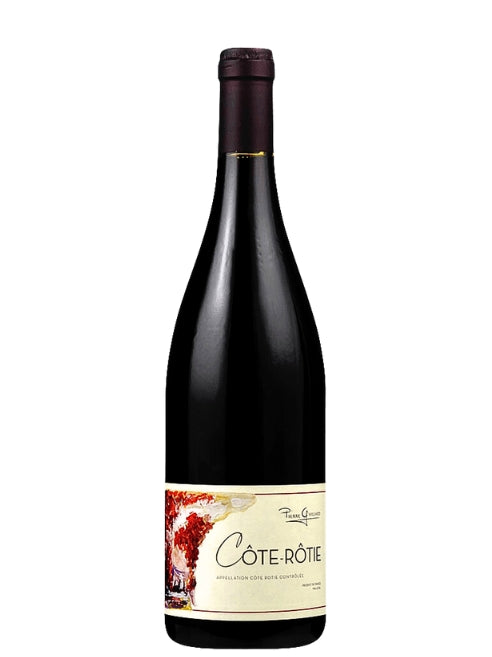Celebrated for its exceptional red wines , Roasted Rib is a wine gem nestled in the far north of the Rhone Valley , 30km south of Lyon.
The name of the steep relief is indeed considered as one of the most beautiful in the French vineyard thanks to the quality of its wines but also for its remarkable vineyard made up of steep slopes overlooking the Rhône. This unique terroir , steeped in history and tradition, gives the wines produced here an inimitable personality.
Through this article, we will therefore delve into the captivating world of Côte Rôtie , where each sip reveals a thousand-year-old story of passion and know-how. Embark on a delicious journey that will allow you to discover the history of the appellation , its grape varieties , its land, or how to taste and ideally pair the region’s wines.
Côte Rôtie: one of the oldest vineyards from France
The history of the Côte Rôtie appellation dates back to Antiquity , testifying to a exceptional longevity as well as a wine tradition deeply rooted.
The first traces of vines date back to Roman times . Philosophers like Pliny the Elder Or Plutarch celebrate so in their writings THE Viennese wine , a name derived from the French city of Vienne, located a few kilometers south of Lyon. Also during Antiquity, the Romans also contributed to the growth of the vineyard by developing new cultivation techniques as well as the wine trade along the river.
Then, at 6th century , the first charters concerning Ampuis and its vineyard appear, gradually delimiting a more precise sector.
In the Middle Ages , Côte Rôtie then gained popularity and the local lords, admiring and appreciating the wines produced on these sunny slopes, encouraged the planting of vines. The steep hillsides in fact promote optimal maturation of the grapes and allow the production of great wines qualitative.
Over the centuries, the reputation of Côte Rôtie wines has been consolidated until it reached its peak in 1890 , a time when 300 hectares of vines were planted. Then, although in 1936 the AOC Côte Rôtie is officially created , the crisis of phylloxera , THE two world wars as well as development of the tree culture , then more profitable, will almost make the vineyard disappear, reducing it to only 40 hectares in the early 1950s .
We will then have to wait for the 70s and 80s so that it can be reborn, in particular thanks to the impetus by Etienne Guigal The eponymous house, the best known of the appellation still today, then serves as locomotive for the entire area and revolutionized winemaking by limiting yields, scrupulously sorting the berries and strictly controlling aging.
Little by little, the phoenix rose from its ashes and young winegrowers established themselves in the appellation, creating a great dynamism. As the years went by, Côte Rôtie (re)became famous in France but also internationally thanks to the quality of its wines.
Today, the AOC extends over 330 hectares on the right bank of the Rhone within three communes: Ampuis, Saint-Cyr-sur-le-Rhône and Tupin-et-Semons. The vineyard evolves between 180 and 325 meters of altitude and is composed of 75 registered places .
At the height of its glory, the AOC has become once again a world reference in the production of red wines equipped with a great aging potential .
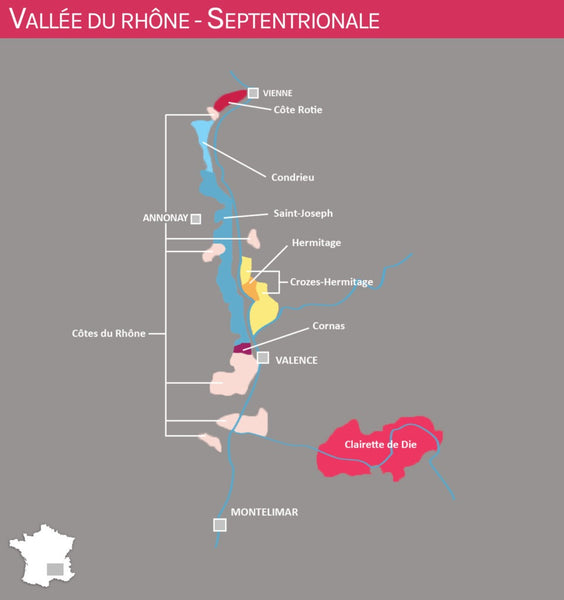
Syrah, Côte Blonde and Côte Brune
But then, what are the components of this vineyard that led it to such success?
Well, Côte Rôtie is first of all a fantastic grape variety: the Syrah . This variety reaches its qualitative peak here and produces of the powerful wines , complex and aromatic endowed of a charming material, structured but smooth tannins as well as a good aging potential.
Lesser known thing, THE Viognier , white grape star of the neighboring AOC Condrieu can also enter into the composition wines of the appellation and this up to 20%! In fact, This rarely exceeds 5 to 10% in wines and it is Syrah which plays the leading roles.
Côte Rôtie is also a local affair . The vines are in fact planted here on steep hillsides bathed in sunlight which can reach 60% inclination. It is from this unique relief that the appellation takes its name: it dates back to the end of the 17th century and echoes the vines burnt and roasted by the sun during the summer period.
This majestic relief nevertheless requires winegrowers to carry out very demanding manual work throughout the year. Thus, in order to support the land and cultivate the vines on terraces, the latter have built dry stone walls locally called "chaillées" .
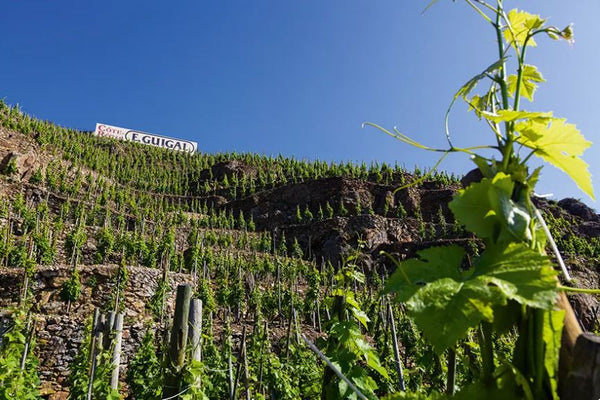
It is also common to split the name into two parts: the Brown Coast to the north , growing on brown soils (iron oxide) and resting on of the micaschists, and the Blonde Coast to the south , developing on lighter-coloured soils and resting on a bedrock of gneiss and migmatites.
Legend has it that in the 16th century, a lord who owned the lands of Côte-Rôtie divided his estate between his two daughters to marry them off as well-endowed women. One was as blond as wheat and the other was as dark as jet... Pure invention, certainly, but poetic!
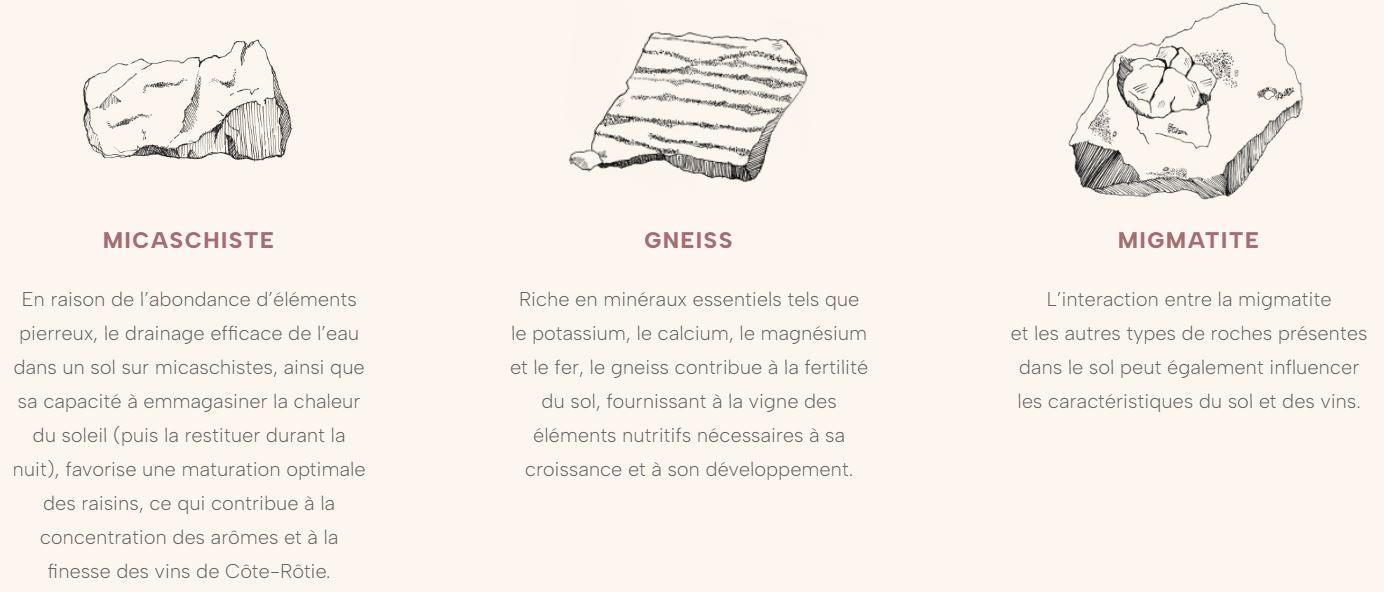
Finally, the climate of the region is semi-continental and benefits of Mediterranean influences . Summers are therefore hot, winters cool and rainfall relatively regular (800 mm per year on average). Moreover, THE warm wind from the south protects the vineyard here against cryptogamic diseases (fungi) and promotes good ripeness.
AOC wines Roasted Rib
As you will have understood, the wines of the AOC Côte Rôtie are generally composed of the unique Syrah grape variety although some vintages can sometimes contain a small amount of Viognier . Therefore, to understand the wines of the appellation, it is necessary to understand these two grape varieties.
Thus, Syrah is a variety allowing the production of seductive and aromatically rich red wines . Tannins are generally very present. in tasting and have a certain roundness making them accessible. The variety also often expresses notes of black fruits (cherry, blackberry), violet and pepper and lends itself well to aging in oak barrels . Syrah certainly allows the constitution of great wines for laying down . If you want to know more, do not hesitate to read our article The Syrah grape variety guide .
On the other hand, the white grape Viognier is a variety with low acidity and the gourmet and generous aromatic . This often evolves on notes of peach, pear, apricot and white flowers . A buttery and vanilla aspect is added to this when the grape variety is aged in barrels. On Côte Rôtie, the use of Viognier aims to soften the tannins of the Syrah and bring an additional aromatic to the wine. If you want to know more, you can also read our article on the Viognier grape variety .
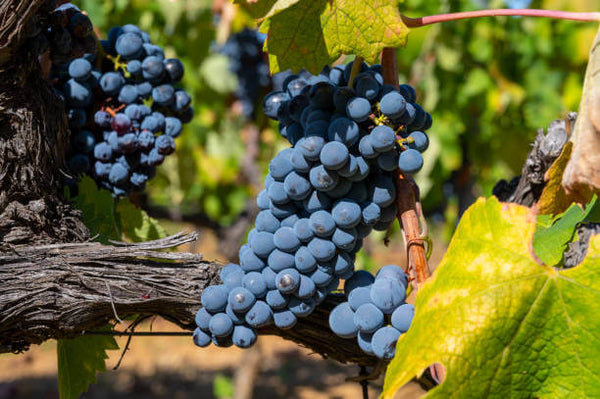
Now that you know these varieties better, let's take a closer look at the wines of the AOC Côte Rôtie. Here, Syrah is considered to be at its northern limit (it is often planted in vineyards with an even warmer climate). However, it is here that it is at its peak: balanced acidity, power, complexity, long aging, Côte Rôtie wines are a model of balance and elegance .
That being said, very different vintages coexist within the appellation . To simplify, we often say that the Brown Coast produces the most wines powerful and complex of the area. On the contrary, the Blonde Coast , produces wines feminine and elegant , more focused on the finesse .
Furthermore, if we had to give a "classic" aromatic of a Côte Rôtie wine, it would give the following: notes of cherry, wild blackberry , of beautiful spices (cinnamon, pepper, clove, cedar etc.), a strong but balanced tannic structure, a touch of violet and sometimes a wooded slightly vanilla .
Be careful though, very many nuances (soils, yields, orientation of the plots, winemaking by the winemaker, etc.) make this description quite caricatured.
That eat with a Côte Rôtie ?
What are the best wines from Côte Rôtie? ?
Conclusion
So you will have understood, the name Côte Rôtie is a magic name which resonates in the ears of all lovers of great red wines . Concentrated over just a few kilometers, this area produces the best Syrahs from France and dazzles tasters from all over the world.
Thanks to its remarkable terroirs , the master appellation of the northern Rhône Valley offers gastronomic vintages with velvety texture and intense aromas.
He Now all you have to do is explore its steep vineyard so characteristic in order to discover all its charms! And if physical effort scares you, another way exists 😉 ... Health !




